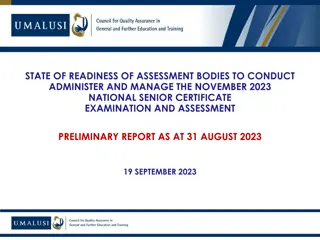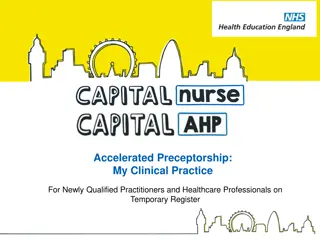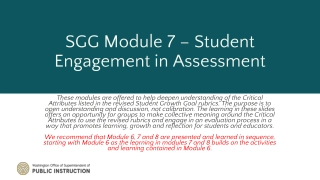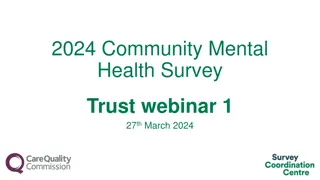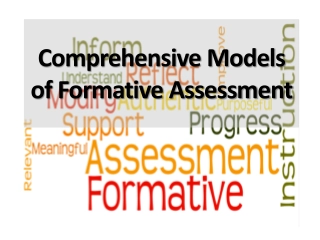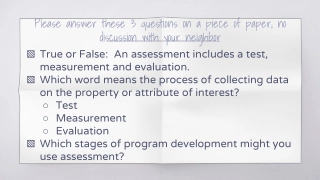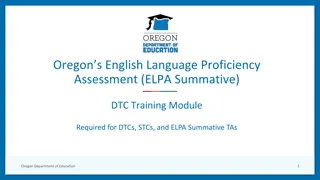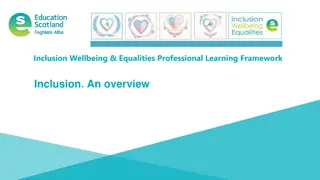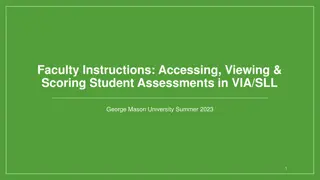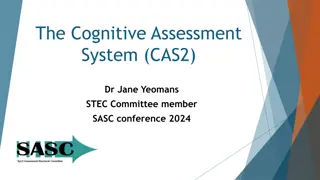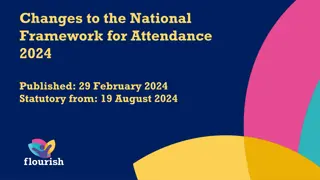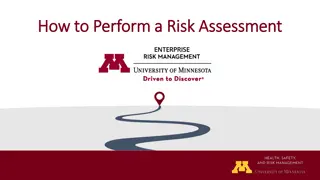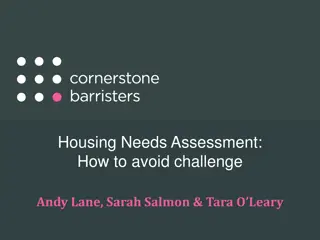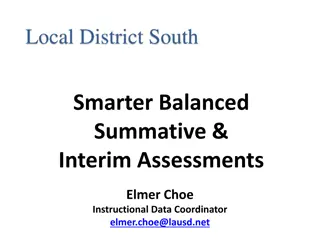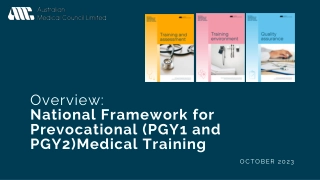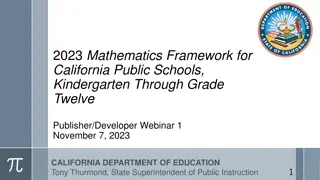Understanding the New CQC Single Assessment Framework
Explore the changes in the updated CQC Single Assessment Framework, including what stays the same and what's evolving. Learn about the new regulatory approach, workshop objectives, and the rationale behind the changes. Discover the emphasis on enhancing care, smarter regulation, safety improvement, and driving overall service improvements. Prepare yourself and your team for the upcoming shifts in regulatory standards.
Download Presentation
Please find below an Image/Link to download the presentation.
The content on the website is provided AS IS for your information and personal use only. It may not be sold, licensed, or shared on other websites without obtaining consent from the author. Download presentation by click this link. If you encounter any issues during the download, it is possible that the publisher has removed the file from their server.
Presentation Transcript
CQC Single Assessment Framework Preparing for the new approach
01 Introduction 02 03 04 05 06 What is staying the same What is changing Quality Statements Evidence Categories Ratings & Reporting
Workshop Objectives Understand more about the new CQC Single Assessment Framework, what is changing and what you can do to prepare as a Leader Understand more about the new CQC Single Assessment Framework, what is changing and what we are doing to prepare your Teams. Prepare for potential Staff & Leadership Feedback Questioning from the CQC Understand the types of questions as Leaders you may be asked and how this could happen.
Background Published in May 2021, CQC s new strategy sets out the regulator s ambitions under 4 themes: 1. People and communities Advocate for change, regulation driven by people s needs and their experiences of health and care services, rather than how providers want to deliver them. Focusing on what matters to the public, and to local communities, when they access, use and move between services. Working in partnership with people who use services, an opportunity to help build care around the person: CQC want to regulate to make that happen. 2. Smarter regulation Smarter in how they regulate. Keeping pace with changes in health and care, providing up-to-date, high-quality information and ratings for the public, providers and partners. Regulate in a more dynamic and flexible way to adapt to the future changes that can be anticipated as well as those that can t. Smarter use of data means targeting of resources to have the greatest impact, focusing on risk and where care is poor, to ensure we re an effective, proportionate and efficient regulator. 3.Safety through learning Stronger safety and learning cultures. Safety is still a key concern as it s consistently the poorest area of performance in CQC assessments. Prioritise safety: stronger safety cultures, focusing on learning, improving expertise, listening and acting on people s experiences, and taking clear and proactive action when safety doesn't improve. 4.Accelerating improvement. Drive improvements across individual services and systems of care. Use unique position to spotlight the priority areas that need to improve and enable access to support where it s needed most. Empower services to help themselves, while retaining a strong regulatory role. The key to this is by collaborating and strengthening relationships with services, the people who use them, and our partners across health and care.
Why is it changing ? To have a greater focus on care across Local Areas or Systems To use new regulatory powers effectively to improve people s care To make regulation less complex and more efficient To regulate in a smarter , technology driven way To work better with the sector as it changes and recovers from CV-19
New Powers The CQC now have new powers to oversee local authorities and integrated care systems under the Health and Care Act 2022. It will be based on three key themes for assessment: Support to deliver the objectives in their strategy of how care provided in a local system is improving outcomes & reducing inequalities Transformative in how they bring together a view of quality across a local area/system. With the new powers, it creates a duty for CQC to enforce the NHS food and drink standards.
Internal CQC Changes CQC have undergone a massive change in structure to support the single assessment framework and new strategy. Merging staff from all the different sectors together as they will be using the same framework. CQC believe that this is beneficial. There will be four geographic areas: South, East (including London) South West Midlands North Across the country there will be between 110- 115 teams with approx. 12 staff in each team. This is to align themselves better to the 42 ICS s.
New CQC Teams Teams will be a mix of inspectors, assessors, co-ordinators and regulatory officers. A Team approach will be adopted by the CQC. Supported by senior specialists National Operations Supported by a Central Hub Regulatory Teams Led by the Chief Inspectors, and focuses on raising standards, policy oversight, and external influence Operational Teams Work across four geographic networks, with a mix of specialist skills and knowledge to regulate in a way that mirrors how care is delivered
What is staying the same? The 5 Key Questions Ratings Categories The 5 Key Questions Ratings
What is changing? A single framework - the same criteria for all services Old system (4 Frameworks) New system One Single Assessment Framework for all providers, local authorities, and integrated care systems
What is changing? New Provider Portal New Portal Will be the way you give all interactions to the Old system CQC Enables you to share info in real-time and provide comment on the information the CQC holds on you As of 1st Nov 2023, majority of providers have not yet received an invitation to the portal Still unclear limits of what can be uploaded
What is changing? New Provider Portal New Portal From August limited providers have been able to: Old system Enrol to the portal Submit four types of notification: SN18 Serious Injury SN18 Events that stop service SN16 Deaths SN18 Deprivation of Liberty Safeguards (DoLS) From November selected invited providers will be able to: Register with CQC for the first time Carry out registration variation activity Submit all types of notification Delegate access to colleagues in your organisation
What is changing? New Provider Portal Key Dates (subject to review) New Portal Old system 5 December 2023: Using the new assessment approach across Bedfordshire, Luton and Milton Keynes ICS area 6 February 2024: North & Midlands region & NHS Trust Well-Led Assessments everywhere 21 November 2023: Early Adopters. (14 services) in the South Region 5 December 2023: The remainder of the South Region 9 January 2024: London & East Region
What is changing? New Provider Portal New Portal Old system Target of March 2024 . All providers will receive a log in to the portal Ensure your contact details are correct
I and We Statements 34 Quality Statements replacing the KLOEs **Not very prescriptive in how you can meet them , only steer is the different categories ** We statement (What is expected of the provider) e.g. Safe systems, pathways and transitions We work with people and our partners to establish and maintain safe systems of care, in which safety is managed, monitored and assured. We ensure continuity of care, including when people move between different services. I statement (What patients believe matters to them) I know what to do and who I can contact when I realise that things might be at risk of going wrong or my health condition may be worsening. When I move between services, settings or areas, there is a plan for what happens next and who will do what, and all the practical arrangements are in place.
We Statements' 34 Quality Statements replacing the KLOEs Caring (5) Responsive (7) Safe (8): 1. Kindness, compassion and dignity, Treating people as individuals Independence, choice and control Responding to people's immediate needs Workforce wellbeing and enablement 1. 2. Learning culture Safe systems, pathways, and transitions Safeguarding Involving people to manage risks Safe environments Safe and effective staffing Infection prevention and control Medicines optimisation 1. 2. Person-centred care Care provision, integration, and continuity Providing information Listening to and involving people Equity in access Equity in experiences and outcomes Planning for the future 2. 3. 4. 3. 4. 3. 4. 5. 6. 5. 5. 6. 7. 8. 7.
WeStatements 34 Quality Statements replacing the KLOEs Well-led (8): Effective (6): 1. 2. Assessing needs Delivering evidence-based care and treatment How staff, teams and services work together Supporting people to live healthier lives Monitoring and improving outcomes Consent to care and treatment 1. 2. 3. 4. 5. 6. 7. 8. Shared direction and culture Capable, compassionate and inclusive leaders Freedom to speak up Workforce equality, diversity and inclusion Governance, management and sustainability Learning, improvement and innovation Partnerships and communities Environmental sustainability 3. 4. 5. 6.
QS & Regulation' 34 Quality Statements replacing the KLOEs All Quality Statements will directly link to the relevant CQC Regulations
QS & Regulation' 34 Quality Statements replacing the KLOEs All Quality Statements will directly link to the relevant CQC Regulations Not offences Harm offences Always an offence Person centred care ( Reg 9) Dignity and respect (Reg 10) Need for consent (Reg 11) Safe care and treatment (Reg 12) Safeguarding service users from abuse and improper treatment (Reg 13) Meeting nutritional and hydration needs (Reg 14) Premises and equipment (Reg 15)
QS & Regulation' 34 Quality Statements replacing the KLOEs All Quality Statements will directly link to the relevant CQC Regulations Not offences Harm offences Always an offence Receiving and acting on complaints (Reg 16) (1)(2)) - info to CQC re Complaints (16(3)) Good governance (Reg 17 (1)(2)) - Info to CQC re good governance (Reg 17(3)) Staffing (Reg 18) Fit and proper persons employed (Reg 19) Duty of candour (Reg 20(2)(a) and (3))
QS & Regulation Regulation 12 Safe Care & Treatment (1) Care and treatment must be provided in a safe way for service users. (2) paragraph include Without limiting paragraph (1), the things which a registered person must do to comply with that (a) assessing the risks to the health and safety of service users of receiving the care or treatment; (b) doing all that is reasonably practicable to mitigate any such risks; **2009-2023 CQC has prosecuted 134 providers (vast majority are Reg 12 or Section 10 unregulated activity) ** (c) competence, skills and experience to do so safely; ensuring that persons providing care or treatment to service users have the qualifications, (d) are used in a safe way; ensuring that the premises used by the service provider are safe to use for their intended purpose and (e) user is safe for such use and is used in a safe way; ensuring that the equipment used by the service provider for providing care or treatment to a service (f) quantities of these to ensure the safety of service users and to meet their needs; where equipment or medicines are supplied by the service provider, ensuring that there are sufficient (g) the proper and safe management of medicines; (h) those that are health care associated; assessing the risk of, and preventing, detecting and controlling the spread of, infections, including (i) persons, working with such other persons, service users and other appropriate persons to ensure that timely care planning takes place to ensure the health, safety and welfare of the service users. where responsibility for the care and treatment of service users is shared with, or transferred to, other
6 New Evidence Categories Scoring 1-4 Scale Feedback from Staff and Leaders Feedback from Partners Processes Observation People's experience of health and care services Outcomes
Peoples experience of Health and Care services Direct to CQC from relatives, people using services or others Patient Survey (FFT) Results (and improvements made) Responses to Concerns & Complaints (and improvements made) Evidence from you about people's experience surveys, responses to concerns and improvements made
3. Feedback from partners Feedback from Partners **Still unclear whether you can challenge feedback from partners ** Commissioners Commissioners Multi Agency Bodies Multi Agency Bodies Other Health & Care Other Health & Care Providers Providers Visiting Visiting Health Health Professionals (Survey) Professionals (Survey)
Observation Observations of Care Internal Observations Internal Observations (e.g. Audit /Spot Checks/QA) (e.g. Audit /Spot Checks/QA) Onsite (aka inspection) observation of Care Onsite (aka inspection) observation of Care Off Off- -site/Remote site/Remote interviews staff staff and and professionals interviews with professionals with Use Use of of Experts Experts by by Experience Experience during visits visits during site site
Processes Processes Patient Pathway Management Risk Policy & Procedure Patient Safety & Incidents Management Training/ Recruit Induction/ Supervision Complaints/ Safeguarding Audits & Action Planning GOOD GOVERNANCE : REGULATION 17
Outcomes Outcomes Patient Outcome Data Patient Outcome Data The So What Question Lesson Learned /Audit Outcomes Lesson Learned /Audit Outcomes Other Measurable Outcomes Other Measurable Outcomes (KPI s, Quality Metrics etc ) (KPI s, Quality Metrics etc )
54% of providers are very or extremely concerned about sharing data and action plans with CQC under the new Single AssessmentFramework. Recent Provider Survey Report2023
Feedback from Staff & Leaders Compliments/ Concerns shared with CQC Staff & Leadership Interviews Onsite Inspections Staff Surveys Focus Groups PIR Whistleblowing
Feedback from Staff & Leaders What the CQC say about this We can gather evidence from people who work in a service either on site or off site, or by using a combination We will carry out site visits when it s the best way to gather the evidence we need. For example, we ll do this to observe the care environment and how staff interact with people Assessment teams can get quick access to specialists to support them in interviewing staff. Inspections: We will spend our time on site speaking to people using the service and the staff.
Feedback from Staff & Leaders What the CQC will ask It is still unknown whether the questions that the CQC ask staff and leaders in interviews will change. The questions currently asked usually include: If staff feel positive about their work. About the culture of the organisation whether it is positive, supportive, open. If staff feel valued and listened to, particularly when they have concerns. Currently inspectors structure their interview questions around the Key Lines of Enquiries. Therefore, it is highly probable that under the new regime, interview questions will be structured around the Quality Statements.
Feedback from Staff & Leaders Activity CQC Discussion Cards Feedback from Staff & Leaders Activity CQC Discussion Cards This is a role-playing exercise where you will work will be assigned a number 1 or 2 ( you must have a 1 +2 in your group) Number 1 s will act as the CQC Inspector Number 2 s will act as themselves You have been provided with several QS focussed discussion cards to prompt the conversation .Your goal is to answer the questions to the best of your ability for 15 -20 minutes After this time, we switch , Number 2 s become the CQC Inspector and Number 1 s become themselves. CQC Inspectors please probe hard, ask follow up questions if needed ! Please rate the response from 1-4. You will have 10 minutes at the end to reflect on your answers and discuss how you could/would improve them . You will have an opportunity to feedback to the group.
Scoring & Ratings Example Scoring 1-4 Scale
Scoring & Ratings Example Scoring 1-4 Scale Upper and Lower limit parameters ( e.g. how far away you are from the next rating) Rating Limiters (currently Well Led ) Still not clear if the current rating limiters will apply . No mention of how the ratings review process will happen. % scores will be used as a benchmarking CQC can update ratings at any time
What Else is Changing ? What else is changing? Always On framework flexible and risk based Date of inspections no longer linked to ratings Ratings may be changed without site visits or looking at all Quality Statements Desktop assessment using digital evidence collected remotely Planned & Responsive Assessment Activity What happen in between these activities Proactive asking for information
Reports & Reporting A collection of summaries and benchmarking will be the basis of reports Standard automated text template will remain Reports will become shorter ! Factual Written for the public not provider Accuracy Challenging will still be in place







